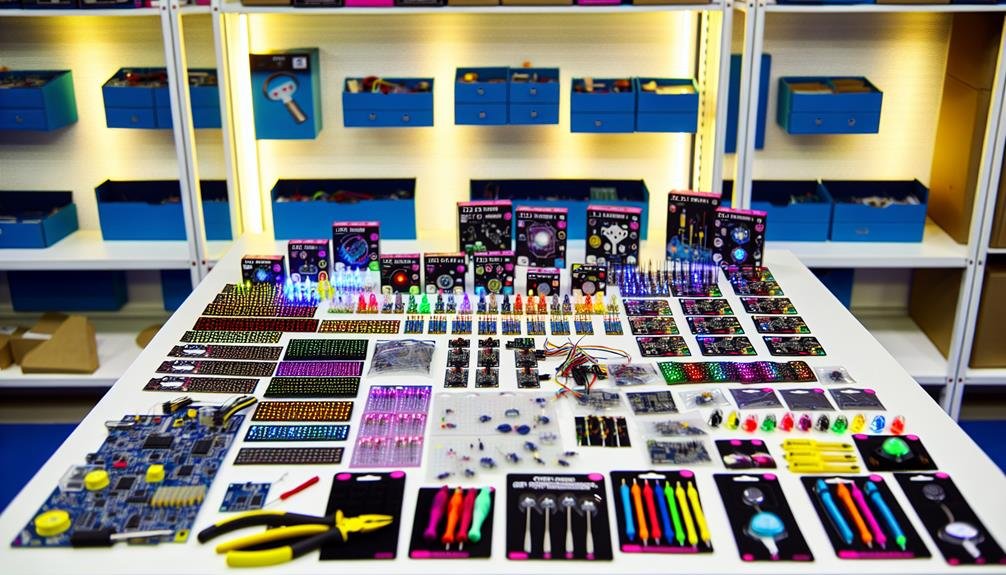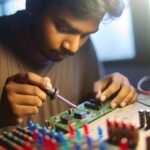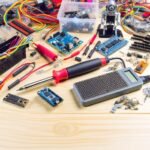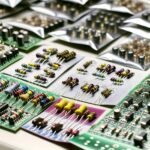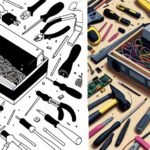Are you interested in exploring the world of wearable technology? Perhaps you've heard whispers of a fascinating realm where creativity and innovation collide, where you can bring your wildest ideas to life.
Well, let's just say there's a way to dip your toe into this exciting world without diving headfirst into the deep end.
Imagine a world of possibilities, where you can create your own wearable devices, all at your own pace and with the guidance of DIY electronics kits.
Intrigued? Stay tuned as we unravel the endless potential that lies within these kits, and uncover the secrets to building your very own wearable technology.
Key Takeaways
- Wearable technology kits cater to different skill levels and offer various electronic projects.
- Popular brands for wearable technology kits include Adafruit, SparkFun, and Lilypad.
- DIY electronics kits contain essential components such as microcontrollers, sensors, LEDs, and batteries.
- Proper soldering and troubleshooting techniques are crucial for successful wearable technology projects.
Types of Wearable Technology Kits
There are several types of wearable technology kits available that cater to different electronic projects and skill levels. Whether you're a beginner or an experienced DIYer, there are options to suit your needs. Popular brands for wearable technology kits include Adafruit, SparkFun, and Lilypad. These brands offer a wide range of kits that allow you to create various wearable devices such as smartwatches, fitness trackers, and even clothing with embedded LEDs.
If you're looking for cost-effective options, there are DIY wearable technology kits available that won't break the bank. For instance, the Adafruit GEMMA Starter Pack is a great choice for beginners. It includes the GEMMA microcontroller, conductive thread, and a variety of sensors and LEDs. Another affordable option is the SparkFun LilyPad Development Board. It's designed specifically for wearable projects and comes with a built-in power supply and multiple input/output pins.
No matter which brand or kit you choose, it's important to consider your skill level and the specific project you want to undertake. Some kits may be more advanced and require knowledge of programming and electronics. Others may be simpler and suitable for beginners. It's always recommended to read reviews and check the compatibility of the kit with your desired project before making a purchase.
Essential Components in DIY Electronics Kits
To understand the essential components in DIY electronics kits, you need to be familiar with the key elements that make up these kits. These components are crucial for building wearable technology projects and can vary depending on the specific kit you choose. However, there are some common components that you can expect to find in most DIY electronics kits for wearable technology.
One of the most important skills you will need when working with DIY electronics kits is soldering. Soldering is the process of joining two or more electronic components together using molten metal solder. It provides a strong and reliable connection between the components, ensuring that your wearable technology project functions properly. Without proper soldering, you may encounter issues such as loose connections or intermittent electrical signals.
In addition to soldering, troubleshooting common issues is another crucial aspect of working with DIY wearable technology projects. Some common issues you might encounter include faulty connections, incorrect circuitry, or malfunctioning components. Troubleshooting these issues requires a systematic approach, such as checking connections, testing individual components, and verifying the circuitry.
To help you visualize the essential components in DIY electronics kits, here is a table that highlights some of the common components you may find:
| Component | Function |
|---|---|
| Microcontroller | Brain of the wearable device |
| Sensors | Collect data from the environment |
| LEDs | Provide visual feedback |
| Battery | Powers the wearable device |
Step-by-Step Guide to Building Wearable Devices
Now that you're familiar with the essential components in DIY electronics kits for building wearable technology, let's dive into a step-by-step guide to actually constructing these innovative devices. Building wearable devices can be a rewarding experience, but it's important to follow the right steps to ensure a successful outcome.
First, gather all the necessary materials and tools for the project. This includes the DIY electronics kit, any additional components you may need, and any recycled materials you plan to incorporate into your design. Speaking of which, incorporating recycled materials isn't only environmentally friendly but also adds a unique touch to your wearable device.
Next, carefully read the instructions provided with your DIY electronics kit. Familiarize yourself with the different components and their functions. This will help you troubleshoot any common issues that may arise during assembly.
Once you understand the instructions, start by connecting the various components together according to the provided diagrams. Pay close attention to the polarity of the components, ensuring that positive and negative terminals are properly aligned.
After connecting the components, it's time to test your wearable device. Check for any loose connections, faulty wiring, or shorts. Troubleshoot any issues by carefully inspecting each connection and ensuring that everything is properly secured.
Top Tips for Successful DIY Wearable Technology Projects
For successful DIY wearable technology projects, it's crucial to carefully plan and prepare before starting the construction process. By avoiding common mistakes and following troubleshooting tips, you can increase the chances of a successful project.
One common mistake isn't understanding the capabilities and limitations of the components you're using. Before starting, thoroughly research and familiarize yourself with the specifications of each component to ensure they're compatible and will work together effectively.
Another mistake is skipping the testing phase. It's important to test each component individually before integrating them into your wearable device. This will help you identify any issues early on and save time and effort in the long run.
Additionally, make sure to document your progress throughout the project. This won't only help you troubleshoot any problems that arise but also serve as a reference for future projects.
Lastly, don't be afraid to ask for help. There are many online communities and forums where you can seek guidance and advice from experienced DIYers. By learning from others and leveraging their expertise, you can overcome challenges and achieve a successful DIY wearable technology project.
Exploring Advanced Features in Wearable Technology Kits
You can delve into the realm of advanced features in wearable technology kits by exploring the various functionalities and capabilities they offer. As wearable technology continues to evolve, it is important to stay updated with the latest trends and challenges in wearable technology design. By doing so, you can make the most of your DIY projects and create innovative and cutting-edge wearable devices.
To give you an idea of what advanced features you can expect in wearable technology kits, here is a table showcasing some of the popular functionalities and capabilities:
| Functionality | Capability | Description |
|---|---|---|
| Biometric Monitoring | Heart Rate Tracking | Measures and tracks your heart rate for fitness and health purposes. |
| Sleep Tracking | Monitors your sleep patterns to provide insights for better rest. | |
| Stress Detection | Measures stress levels and provides recommendations for stress management. |
